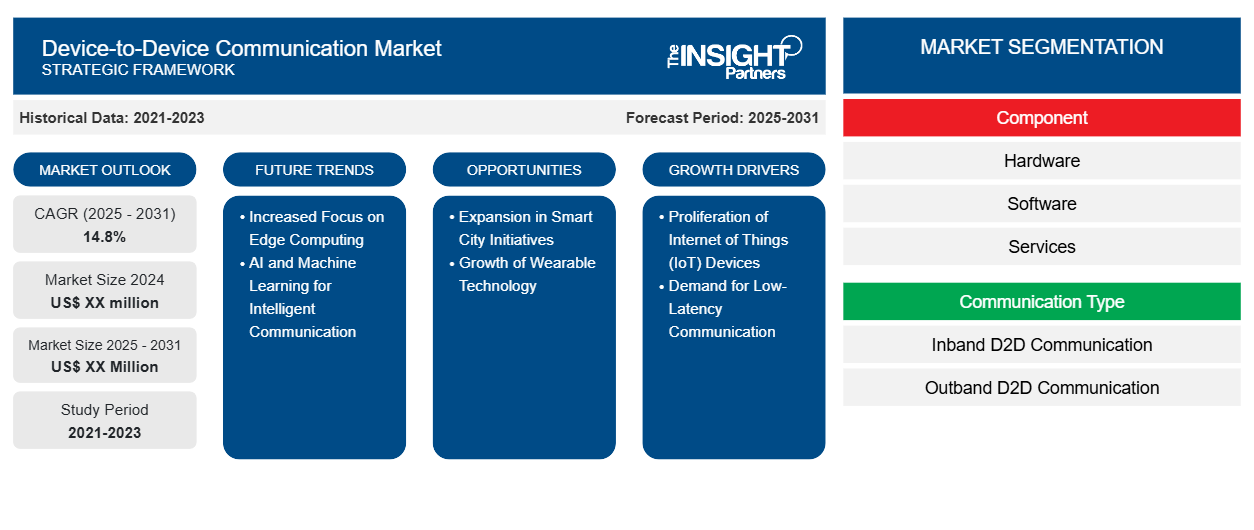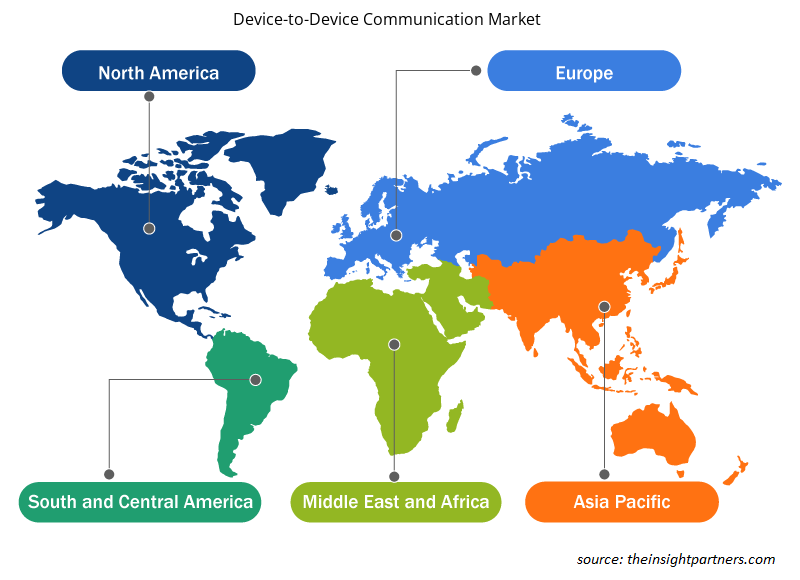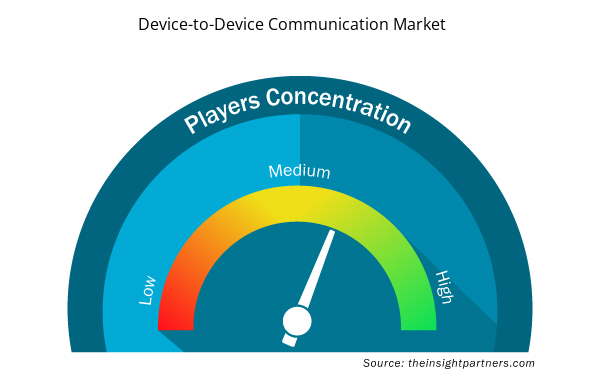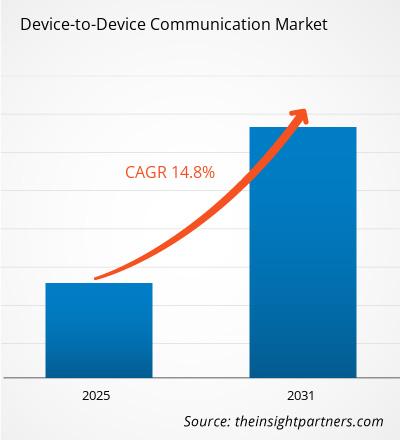The Device-to-Device Communication Market is expected to register a CAGR of 14.8% from 2025 to 2031, with a market size expanding from US$ XX million in 2024 to US$ XX Million by 2031.
The report is segmented by Component (Hardware, Software, Services); Communication Type (Inband D2D Communication, Outband D2D Communication); Application (Vehicle-to-Vehicle (V2V) Communication, Public Safety Services, Content Distribution, Cellular Offloading, Others); Geography (North America, Europe, Asia-Pacific, Middle East & Africa, South and Central America).
The global analysis is further broken-down at regional level and major countries. The report offers the value in USD for the above analysis and segments
Purpose of the Report
The report Device-to-Device Communication Market by The Insight Partners aims to describe the present landscape and future growth, top driving factors, challenges, and opportunities. This will provide insights to various business stakeholders, such as:
- Technology Providers/Manufacturers: To understand the evolving market dynamics and know the potential growth opportunities, enabling them to make informed strategic decisions.
- Investors: To conduct a comprehensive trend analysis regarding the market growth rate, market financial projections, and opportunities that exist across the value chain.
- Regulatory bodies: To regulate policies and police activities in the market with the aim of minimizing abuse, preserving investor trust and confidence, and upholding the integrity and stability of the market.
Device-to-Device Communication Market Segmentation
Component
- Hardware
- Software
- Services
Communication Type
- Inband D2D Communication
- Outband D2D Communication
Application
- Vehicle-to-Vehicle Communication
- Public Safety Services
- Content Distribution
- Cellular Offloading
- Others
Geography
- North America
- Europe
- Asia-Pacific
- South and Central America
- Middle East and Africa
Customize This Report To Suit Your Requirement
You will get customization on any report - free of charge - including parts of this report, or country-level analysis, Excel Data pack, as well as avail great offers and discounts for start-ups & universities
Device-to-Device Communication Market: Strategic Insights

- Get Top Key Market Trends of this report.This FREE sample will include data analysis, ranging from market trends to estimates and forecasts.
Device-to-Device Communication Market Growth Drivers
- Proliferation of Internet of Things (IoT) Devices: The rapid expansion of IoT devices is a primary driver of the device-to-device (D2D) communication market. As more devices become connected, ranging from smart home appliances and wearables to industrial sensors and vehicles, the need for efficient communication between these devices becomes crucial. D2D communication enables seamless data exchange, enhances responsiveness, and supports real-time decision-making, making it an essential component of IoT ecosystems. The increasing number of IoT devices is significantly boosting the demand for D2D communication solutions.
- Demand for Low-Latency Communication: With the rise of applications requiring real-time data exchange, such as autonomous vehicles, smart cities, and augmented reality (AR) experiences, there is a growing demand for low-latency communication. D2D communication can reduce the latency associated with traditional network communication by enabling devices to communicate directly with each other without routing data through a central server. This capability is critical for applications that require instant responses and high reliability, driving the adoption of D2D communication technologies.
Device-to-Device Communication Market Future Trends
- Increased Focus on Edge Computing: The trend towards edge computing is influencing the D2D communication market by enabling data processing closer to the source of data generation. This shift reduces latency and bandwidth usage while enhancing the real-time capabilities of D2D communication. In edge computing environments, devices can communicate directly with each other to make immediate decisions without relying on centralized cloud servers. This trend is driving the development of D2D communication solutions that leverage edge computing architectures for improved performance.
- AI and Machine Learning for Intelligent Communication: AI and machine learning (ML) are being integrated into D2D communication systems to improve efficiency and decision-making. By enabling devices to "learn" from interactions, these technologies can optimize communication pathways, predict potential failures, and enhance data processing. AI/ML-driven systems can also enable autonomous decision-making among devices, leading to more adaptive and intelligent networks for smart homes, industrial IoT, and healthcare devices.
Device-to-Device Communication Market Opportunities
- Expansion in Smart City Initiatives: The concept of smart cities is gaining traction globally, presenting significant opportunities for D2D communication technologies. As urban areas seek to improve infrastructure, enhance efficiency, and deliver better services to citizens, D2D communication can facilitate the interconnection of various city services and devices, such as traffic management systems, public transportation, and energy grids. Vendors that develop D2D solutions tailored for smart city applications, including real-time monitoring and automated response systems, can capitalize on this growing trend.
- Growth of Wearable Technology: The increasing popularity of wearable devices, such as fitness trackers, smartwatches, and health monitoring devices, is creating new opportunities for D2D communication. Wearable technology often relies on quick data exchange between devices for functionalities like health monitoring, notifications, and fitness tracking. By enabling efficient communication between wearables and other connected devices, such as smartphones or home automation systems, D2D communication can enhance the user experience and drive the adoption of wearable technologies in various sectors, including healthcare and fitness.
Device-to-Device Communication Market Regional Insights
The regional trends and factors influencing the Device-to-Device Communication Market throughout the forecast period have been thoroughly explained by the analysts at Insight Partners. This section also discusses Device-to-Device Communication Market segments and geography across North America, Europe, Asia Pacific, Middle East and Africa, and South and Central America.

- Get the Regional Specific Data for Device-to-Device Communication Market
Device-to-Device Communication Market Report Scope
| Report Attribute | Details |
|---|---|
| Market size in 2024 | US$ XX million |
| Market Size by 2031 | US$ XX Million |
| Global CAGR (2025 - 2031) | 14.8% |
| Historical Data | 2021-2023 |
| Forecast period | 2025-2031 |
| Segments Covered |
By Component
|
| Regions and Countries Covered | North America
|
| Market leaders and key company profiles |
Device-to-Device Communication Market Players Density: Understanding Its Impact on Business Dynamics
The Device-to-Device Communication Market market is growing rapidly, driven by increasing end-user demand due to factors such as evolving consumer preferences, technological advancements, and greater awareness of the product's benefits. As demand rises, businesses are expanding their offerings, innovating to meet consumer needs, and capitalizing on emerging trends, which further fuels market growth.
Market players density refers to the distribution of firms or companies operating within a particular market or industry. It indicates how many competitors (market players) are present in a given market space relative to its size or total market value.
Major Companies operating in the Device-to-Device Communication Market are:
- Telefonaktiebolaget LM Ericsson
- Intel Corporation
- Texas Instruments Incorporated
- Qualcomm
- Rohde and Schwarz
Disclaimer: The companies listed above are not ranked in any particular order.

- Get the Device-to-Device Communication Market top key players overview
Key Selling Points
- Comprehensive Coverage: The report comprehensively covers the analysis of products, services, types, and end users of the Device-to-Device Communication Market, providing a holistic landscape.
- Expert Analysis: The report is compiled based on the in-depth understanding of industry experts and analysts.
- Up-to-date Information: The report assures business relevance due to its coverage of recent information and data trends.
- Customization Options: This report can be customized to cater to specific client requirements and suit the business strategies aptly.
The research report on the Device-to-Device Communication Market can, therefore, help spearhead the trail of decoding and understanding the industry scenario and growth prospects. Although there can be a few valid concerns, the overall benefits of this report tend to outweigh the disadvantages.
- Historical Analysis (2 Years), Base Year, Forecast (7 Years) with CAGR
- PEST and SWOT Analysis
- Market Size Value / Volume - Global, Regional, Country
- Industry and Competitive Landscape
- Excel Dataset



Report Coverage
Revenue forecast, Company Analysis, Industry landscape, Growth factors, and Trends

Segment Covered
This text is related
to segments covered.

Regional Scope
North America, Europe, Asia Pacific, Middle East & Africa, South & Central America

Country Scope
This text is related
to country scope.
Frequently Asked Questions
Some of the customization options available based on the request are an additional 3-5 company profiles and country-specific analysis of 3-5 countries of your choice. Customizations are to be requested/discussed before making final order confirmation# as our team would review the same and check the feasibility
The report can be delivered in PDF/PPT format; we can also share excel dataset based on the request
Increased Focus on Edge Computing is anticipated to play a significant role in the global Device-to-Device Communication Market in the coming years
Proliferation of Internet of Things (IoT) Devices and Demand for Low-Latency Communication are the major factors driving the Device-to-Device Communication Market
The Device-to-Device Communication Market is estimated to witness a CAGR of 14.8% from 2023 to 2031
Trends and growth analysis reports related to Technology, Media and Telecommunications : READ MORE..
1.Telefonaktiebolaget LM Ericsson
2.Intel Corporation
3.Texas Instruments Incorporated
4.Qualcomm
5.Rohde and Schwarz
6.Samsung
7.Huawei Technologies
8.Nokia Corporation
9.Google LLC
10.Microsoft Corporation

 Get Free Sample For
Get Free Sample For